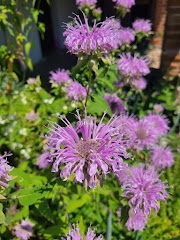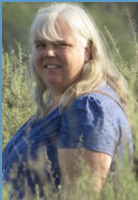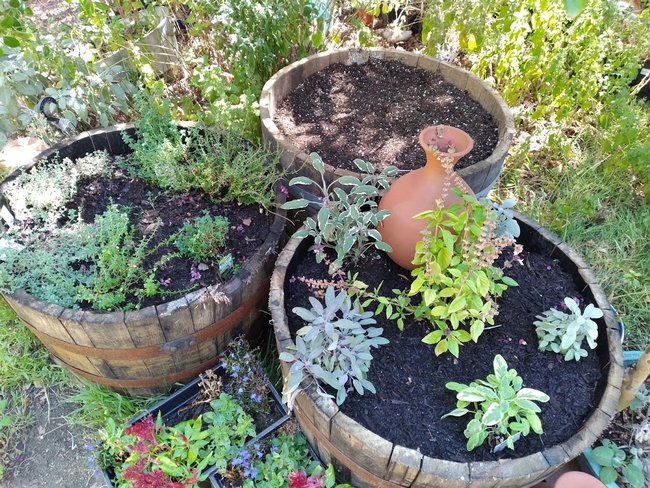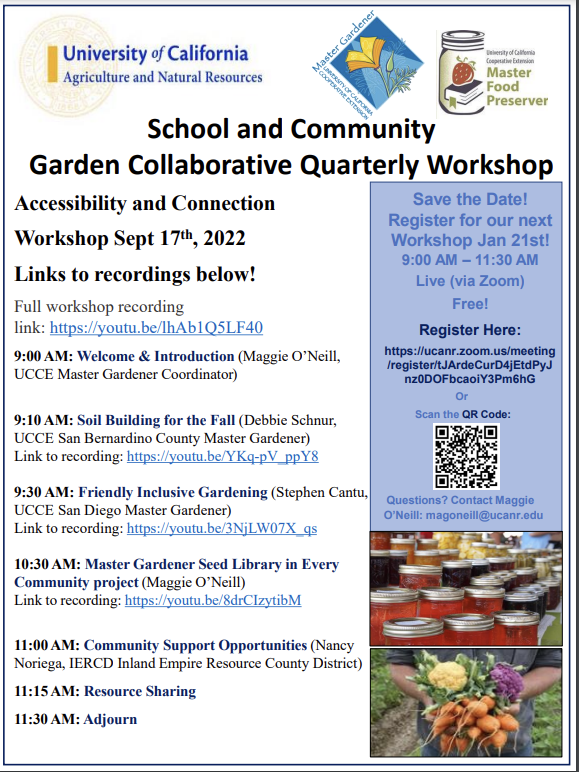- (Public Value) UCANR: Developing an inclusive and equitable society
- Author: Margaret J O'neill

- A garden is a work in progress, and that means reevaluating your goals, design, and needs every so often! When I talk to people about gardening, I like to remind them (and myself!) that gardening is a journey, not a destination. That means a garden is never really “done,” and that's a good thing. The relationship we have with our garden, and the time spent outside, is vital for not only the health of our planet but for ourselves as well. With that in mind I like to do seasonal check-ins with my garden to see what plants are working and what aren't. I consider what hardscape features I could add to make my garden more functional in the rain or extreme heat. These check ins can not only help keep your garden looking it's best they can also help keep you engaged, or reengaged, in your garden even if you sort of “fell of” for a season or two because of life, etc!
2. This rain has greened up things that might not be practical to keep green under another more drought and water restrictions (we're still there!). Nature blessed us with some serious water this spring, and I'm seeing so many things that are green that haven't really looked their best in years. I must remind myself that in my area I got about 30 inches of rain, about 18 inches above average, and that is not sustainable if I needed to water those plants to keep them going. With that in mind, I am noting which plants might not be best suited for my yard since they do best with more water than I am usually able to provide, and that can help me decide what to keep and what not to keep. For plants that I am really attached to, I am thinking of ways to help reduce moisture loss, like adding mulch, and also thinking about ways that I can extend the water I have through rain catchment, berms and swales, and greywater (for non-edibles), or setting up more efficient irrigation systems.
3. If you're pressed for time in the garden or have a big space that you want to rejuvenate, consider breaking your space into sections to make tackling the job easier. There are lots of ways to mentally divide up your garden space. You can think about the plants function, like pollinator habitat, food gardening, fruit trees, ornamental plants, native habitat, etc. You can also think about your space in terms of how things are planted, like in containers, in the ground, in raised beds, etc. In my garden I also have added a layer of what I like to do in each space. So, for example I have a meditative or relaxing space, my herb garden, my native habitats, and a small orchard. These spaces aren't that large but giving them a “theme” helps me decide where I am going to work on any given day, and I just sort of rotate around to give even attention to all. This can also help me decide that “today I am going to work on cleaning up my (neglected) meditation area” so I don't feel so overwhelmed by all the garden chores I need to do (really sounds like I need that meditation space to be up and running!!).
4. Another way to break up garden chores that might seem overwhelming is to focus on specific tasks. This is a technique I use regularly in my garden. I will decide that “today I am going to just move mulch, or work on my compost pile, or prune fruit trees off the ground to help keep ants out…..” This single task might be something I do in multiple areas of the garden, but I can bring out one set of tools, or stay focused on one task and can really get a lot done.
- Don't forget that the “little by little” approach can move mountains (of mulch for example)! I am amazed at how much I can get done that way. Just spending 15 min a day in my garden can show results in a week's time. The same goes for a big pruning or weeding job, or any other big task that you are doing yourself. Sometimes I get overwhelmed at the tasks that lie ahead of me, but I can tell you from experience that working in the yard for 15 min a day is a lot more productive than the weeks I spent just thinking about how big of a job something is! That short time in the garden is also a great way to clear your head each day and it can become a great part of your healthy lifestyle routine. Getting into a routine can help you get back into gardening more easily if you've had things that have kept you from garden for a few days or even weeks.
- Lastly, be patient with yourself and your garden. When you see amazing gardens at your neighbor's house, or online, don't compare your garden to theirs in a judgmental way. They may have lots of garden helpers or be retired with plenty of time on their hands. They may have also just found their gardening groove….a routine that works for them that keeps them getting into the garden on a regular basis, even if it's just for a short interval each time. I try to look at those “ideal” gardens and see what's possible, what I like and don't like, and think about how I may be able to incorporate it into my garden over time. Last year I wanted to add more herbs to my garden, and took the little by little approach. After a year I am amazed at the little herb forest I have going and am so impressed by how my little efforts paid off. Some things I planted last year also didn't work, but I took a few min here and there to think about why certain things didn't work in that microclimate. I recommitted to some things this year that I really wanted to see come together and let some other things go that just didn't work for me (and my schedule or desired water usage), and that's ok too. Be kind to yourself in your garden and remember that it's a journey and not a destination! It's amazing what can be accomplished over time with just a little consistent investment each day or week.
Hopefully these tips help you feel empowered to tackle even the most neglected space! We would also love to hear about your gardening strategies to keep your garden at its best, so join our classes on revitalizing your garden to share your stories or if you need some more ideas end encouragement to get it done!
- Author: Margaret J O'Neill
This month's spotlight is on UCCE San Bernardino County Master Gardener Donna Palmer. She has been a Master Gardener (MG) for a few years, joining during our first virtual class in 2021. She is a natural teacher and has taken on the role of being a MG like she had been doing it her whole life. She has done many talks for the community, and was a great support when we were in our initial stages of doing online talks, taking on the cohost role, and teaching us the fundamentals of what a good cohost was! She has taken this skill she has as a presenter and cohost on to help train her fellow MGs in that role and it is so appreciated! Be on the lookout for Donna giving talks in 2023 (they are great!) and also check out her articles in the Chino Champion on gardening as well. You will learn more from Donna below about her gardening passions, and I hope you too will feel excited about gardening all over again when you read Donna's thoughts from the garden.
-Maggie O'Neill, UCCE San Bernardino County Master Gardener Coordinator
Why did you decide to be a MG?
I've long wanted to become a member of this community of gardeners and garden educators but was too shy to actually do it. When classes went online during lockdown, my husband suggested I use the opportunity to achieve my goal. Now I can't believe I waited so long!
What are your gardening passions?
Absolutely everything! I love a garden, learning about plants and plant families, trying something new in my garden beds, tracking growth and experimenting with techniques, harvesting and cooking from the garden, photographing the garden, teaching about gardens, reading about gardens, visiting gardens or nurseries or farms…. You get the idea. If I had to choose two of my very favorite things they would be teaching basic gardening and practicing plant propagation. There's nothing like watching a student discover the sights, textures, and smells of a garden. Witnessing a new gardener relish a sun kissed tomato or devour a fresh crunchy green almost brings me to tears. And I love populating a new area of the garden with the progeny of my own plants.
What do you think gardening gives back to our community and why do you think it's important for overall community health?
What doesn't a garden give back? The solitary gardener gains a nutritious harvest while building soil, promoting neighborhood habitat, supporting pollinators, beautifying a site, and enriching individual well being. Not to mention achieving a sense of accomplishment with every bloom or harvest. And I've never met a gardener who didn't want to share a harvest or favorite seed. Something about plant stewardship nurtures people and creates community. Gardening within a group does all of this on a larger scale. Gardens beckon us in. They invite us to become aware and participate. They prompt us to share and to nourish one another.
Do you have any tips for the community about conserving water in the drought?
I'm learning to garden in a drought just like every other gardener. Drip irrigation, mulch, and Waterwise plants are becoming my best gardening friends.
What is a tidbit or two you've learned as a MG that the public reading our newsletter could gain from?
Nurturing a plant to harvest is a skill. It's ok to experiment and fail and try again. Gardens are hard work for all of us. The most experienced gardeners earned their gardens one plant at a time.
What advice would you give someone considering becoming a UCCE MG?
Do it! The community of Master Gardeners is welcoming, supportive, exciting, and fun. You and your new friends will find opportunities to learn, grow, and make a difference.
- Author: Margaret J O'Neill
Getting to know your Potting Containers: When a container isn't just a container
When choosing a container for your potted plants there's lots of things to consider. I often find myself making selections based on what I already have in my yard that I can reuse and what will be big enough to for my plant, but there's more to it than that. Container material adds another layer to your yards microclimates and it's something you can use to your advantage to fine tune finding just the right spot/microclimate in your yard. Alternatively, if you are planting in what you have and what you find, (which is what I often do), then knowing the different considerations to make regarding your containers material will help keep your plants happy and healthy.
Brown/Light Colored Plastic:
Benefits: Inexpensive; lightweight; comes in many sizes and shapes; cooler than darker colored pots; usually keeps vertebrate pests out of bottom of pot
Challenges: Cooler than black pots (so that's a benefit, unless you live in a cooler area, or in the winter, and the difference is minimal); not recyclable in most cities, so if they break or when they get old they need to go in the trash if they can't be upcycled for another garden purpose; don't usually provide much insulation or heat protection for new transplants, sensitive plants, or smaller plants
How to use it to increase your microclimates: Overall, great for plants that you might want to move around since they are lightweight; can be reused for many years; great for annual plants that you want to dump and refresh the soil each year/season since they pot itself doesn't add much weight; great for plants that you are worried about getting water logged (as long as they have a drain hole, which is a must!) since the pot itself doesn't retain any water….that also means you need to watch that they don't dry out more often then plants in ground or in other types of pots.
Black/Dark Colored Plastic:
Benefits: Many of the same benefits as above, but can also add that black pots tend to absorb heat and might be good for plants (esp in the cooler seasons) that need a little more warmth, or like warm roots
Challenges: Many of the same drawbacks as the pots above, but will absorb more heat than lighter colored pots so it's important to keep an eye on that during warmer weather
How to use it to increase your microclimates: Again, same benefits as light colored pots, but also can be used to keep plants a little warmer if that is something they benefit from.
Note: The descriptions above fit most pots that you buy plants and trees in at the garden center, but note that those pots are often much thinner than the brown or light colored pots you would buy at the store for planting. The pots' thin plastic doesn't provide much insulation from heat or cold and plants in these pots tend to dry out very quickly. These pots are also not usually recyclable but could be used to start seeds, or could be donated to friends, family, or to a community garden near you that might want to start their own seeds or cuttings.
Wood (sealed gaps/not sealed): If you are thinking about making your own planters, containers, you want to think about the type of wood you are using (treated or not for example) with what type of crops. For ornamental plants that you are not eating it is less crucial that you use untreated wood, but the chemicals in treated wood still might be an area of concern with regards to overall soil contamination (even if it is in small amounts)
Benefits: Nice, natural look; biodegradable; wood absorbs some heat/cool and helps buffer soil temperature; Wood will absorb water and that can help buffer temperature of soil and soil moisture. Some wood pots have their seams and insides sealed and some don't. This will impact how much water is absorbed and how much water leaks out as you water. Note this when getting to know your soil in these types of pots.
Challenges: Often more expensive that plastic pots; can be pretty heavy depending on size and if it's able to absorb water (sealed vs unsealed); biodegradable is also a potential down side, especially if you use it for a perennial plants since pot material will break down over time (some will last for a few seasons, some for many, many years depending on wood type); bottoms will often rot out sooner than sides and burrowing pests like gophers can get into them
How to use it to increase your microclimates: Great foundational pots for your garden if you get bigger ones (like half wine/whisky barrels) or smaller containers can be moved around. Wood can buffer soil temperature and also help keep moisture in. Wooden pots can also absorb water from soil, so whether the pots are sealed or lined will make a difference on that, and you need to get to know how this pot interacts with your soil and plants that you choose for these pots
Glazed ceramic:
Benefits: Nice looking pots that often add color and beauty to the garden! Glazed ceramic pots are one of the more expensive options and if you're on a budget, but would like to incorporate this type of pot into your garden, consider using just a few (or even one) to add a pop of color! Can also buffer soil temperatures in cooler areas or times of year; keeps vertebrate pests out of bottom of pot
Challenges: These pots present lots of challenges in San Bernardino County in warmer weather absorbing a lot of heat during warmer months; don't absorb water because the ceramic is sealed, but that also means that they get water logged more easily; many plants that are more herbaceous/tender that will struggle with the radiating heat off this type of pot; these pots are often heavy compared to unglazed ceramic pots.
How to use it to increase your microclimates: Great for a pop of color for your garden! These pots do well with succulents and other plants that can tolerate the radiating heat in the summer. Plants that are more tolerant (or you are willing to carefully water, checking before watering) of some standing water are good choices for these pots.
Metal containers/beds with bottoms: Note that many metal planter beds and containers are insulated with straw or other material to protect plants from over heating on hot days when the metal gets hot. Any liner or insulation you add will have an impact (sometimes negative, sometimes positive) on water absorption, amount of soil you can add, and more, so it's important to do a little research and be observant, looking for plant health issues, or at how quickly the soil dries out.
Benefits: Vertebrate pests will not be able to get through material to get into container (although they still can go over the sides); depending on any insulation you use this might help with buffering soil temperatures, but if soil is in contact with metal temperatures in the soil will fluctuate with outside hot and cold temperatures
Challenges: Metal will get very hot in the summer (and can get very cold in summer); can be challenging to add more drain holes if needed; can be heavy depending on size
How to use it to increase your microclimates: These containers are often used when gardening on cement or other hard surfaces, or areas where planters may be temporary; also useful in areas with lots of gophers or other burrowing vertebrate pests.
Upcycled containers: these can vary widely depending on what type of material you are using and upcycling
Benefits: great to reuse containers, and can end up with lots of creative “yard art”
Challenges: must keep in mind what type of plants you are planting (edible or not) and what materials the upcycled containers are made of, so that you are not exposing yourself to any undesirable chemicals; when in doubt reach out to our Master Gardeners helpline (By phone:(909)387-2182
By email: mgsanbern@ucanr.edu) to find out more about the type of container you would like to use!
Lastly, it's important to have drain holes in your pots to keep plants from sitting in standing water. You might need to add drain holes or adjust your watering accordingly to keep plants healthy. A variety of pots in your yard are a great way to get benefits from all these different container types or using one type in your yard will help you keep some things in your garden more constant!
- Author: Margaret J O'Neill
School and Community Garden Collaborative Quarterly Workshop was on the 17th and it was great! Did you miss it? Check out the recordings here:
Full workshop link: https://youtu.be/lhAb1Q5LF40
Building your Soil presentation: https://youtu.be/YKq-pV_ppY8
FIG (Friendly Inclusive Gardening) presentation with Stephen Cantu: https://youtu.be/3NjLW07X_qs
Seed Library in Every Community Short Introduction (Check this one out if you want to see a new program we are offering to the public, and email me if you want to be involved!): https://youtu.be/8drCIzytibM
Join us for this quarters School and Community Garden Collaborative Workshop! We are getting into our second year hosting this collaborative here in San Bernardino County and it's been great to watch it grow! There are many people throughout our large county working on school and community gardens and we wanted a way to bring them together to discuss ideas, brainstorm challenges and share success. Over the last year we have featured some amazing school garden projects and highlighted some really innovative community gardens.
This quarters workshop will feature a UCCE Master Gardener from San Diego, Stephen Cantu, who has done some amazing work in the area of accessible gardening for all. After living for many years with a mobility limiting injury, he developed what he calls the FIG program, or Friendly, Inclusive Gardening Program. Research has shown that access to gardening is so important for physical, emotional, and mental health. We want everyone to have access to gardening and Stephen Cantu will join us to talk about how to make that happen!
Our Master Gardeners will be rolling out our “Seed Library in Every Community” project to support schools and community gardens who want to start a seed library for their students and community members. In addition to just having a supply of seeds at your site we will also teach the community all about seed harvesting, cleaning, storing, and seed starting.
We will also be hearing from one of our partners and supporters, including IERCD (Inland Empire Resource Conservation District) about all the great things they are doing in the community. Save the date for our next workshop on Jan 21st! Register below! It is open to all whether currently involved in a school or community garden or just interested in perhaps doing so! Also feel free to join and share upcoming events and activities at your community or school garden!
https://vms-mg.ucanr.edu/calendar/cal_view_event.cfm?caleventnum=538976&mgcat=
- Author: Margaret J O'Neill
This month's UCCE San Bernardino County Master Gardener Spotlight is on volunteer Carolyn Paul. Since I first met Carolyn, when she went through the program in 2019, it was clear that she looked at gardening and all its benefits with a holistic view. She sees the beauty in the flowers and trees, but doesn't forget that actually interacting with the garden is half the fun and benefit of gardening! When Master Gardeners were starting the compost project at the Root 66 Garden in Rancho Cucamonga (read here to learn more about that great project https://ucanr.edu/b/~B3D) Carolyn jumped right in to help get that project started by helping to build the boxes, turning the compost and more! She has also worked extensively with both our School and Community Garden committees, helping to organize the outreach and support that the Master Gardeners provide to the public so that youth, adults, and families can all maximize the benefits of gardening. Carolyn's insight on how to connect the Master Gardeners to the community has been an invaluable contribution to our program and San Bernardino County as a whole. She gardens with heart, and takes the time to share that enthusiasm, imparting her wisdom on the benefits of gardening with the community every chance she gets. To hear more about her love of gardening and her thoughts on the benefits of gardening, read more from Carolyn in her own words below.
-Maggie O'Neill, UCCE San Bernardino County Master Gardener Coordinator
Why did you decide to be a MG? I grew up gardening with my parents and grandparents. And when I started my own family, we all have gardened together. So, gardening for me has been a social experience, one filled with fond memories. So in wanting to volunteer, I thought that Master Gardeners would provide a similar social environment where we could all enjoy one another's company and learn from it!
What are your gardening passions? For many years I've grown flowers of all colors and fragrances. Thanks to Master Gardeners, however, I've expanded my love of colors and fragrances in my yards to drought tolerant plants. So now both of our yards have Grevilleas, Lions' Tails, white Lantana, Fairy Dusters, and Hot Lip Sage. They need much less water to stay green and bloom than my flowers.
What do you think gardening gives back to our community and why do you think it's important for overall community health? I think that gardening has the potential to benefit everyone! As individuals we can gain a sense of well-being and accomplishment from it, as well as take advantage of the exercise that it offers. Since we heavily rely upon many technologies in our daily lives, it can be helpful to get outdoors and see how good that connecting with nature can make us feel, physically and psychologically. And gardening can bring people together in a number of positive ways. It can lead to neighbors sharing cuttings and other items from their yards. Most importantly our Master Gardener classes and events
not only provide information to the communities that we serve, but they can also facilitate new friendships and partnerships along the way.
Do you have any tips for the community about conserving water in the drought? Since being a Master Garderner, I've come to better understand the need for water conversation and how my family and I can contribute to it in caring for our yards. We have replaced some of our older, water-thirsty plants with drought tolerant ones. We've mulched wherever we could. And we now have the front and back yards on a watering schedule. On June 1st our local water district required that our city start mandated water rationing. Watering outside is now confined to one day a week for sprinkler watering above ground. Underground watering systems and hand watering are not confined to a specific number of days, but each residence and business has been given a monthly table to follow based upon our previous 2020 total water usage. For each month, we are allotted a portion of this past usage for both indoor and outdoor watering. This has not been easy, since we had to make changes in our use of water inside the house to make certain that we have sufficient water for all our trees and plants. We also removed our pool in order to balance our indoor and outdoor water needs, and to manage the increasing cost of our water.
What is a tidbit or two you've learned as a MG that the public reading our newsletter could gain from? I've learned many, many things from the Master Gardener program. But what stands out the most for me is becoming serious about the close connection our gardening habits have with the climate changes that we are now living with, coupled with the need to be flexible and creative in how we care and nurture our landscape that is threatened by these serious changes. Master Gardeners are important in educating our local communities on how to adapt to climate changes in positive, optimistic ways.
What advice would you give someone considering becoming a UCCE MG? During one of my MG training meetings, I won a copy of the book Biophilia written by Edward O. Wilson! It was enriching to read and confirmed my decision to join Master Gardeners, so I would briefly talk about its message with anyone thinking about being a Master Gardener, since it describes our human bond with other living things, which can easily be ignored: “………to the degree that we come to understand other organisms, we will place a greater value on them, and on ourselves.” (Prologue, Biophilia (1984).







